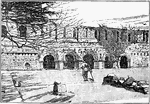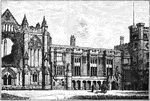Clipart tagged: ‘dissolution of monasteries’

Furness Abbey
Founded in 1123 by Stephen, Count of Blois, it was built originally for the Order of Savigny. Located…

Newstead Abbey
Newstead Abbey, in Nottinghamshire, England, originally an Augustinian priory, is now best known as…

Valle Crucis (Cistercian)
Valle Crucis Abbey (Welsh: Abaty Glyn y Groes or Abaty Glyn Egwestl) is in the Dee (Dyfrdwy) valley…